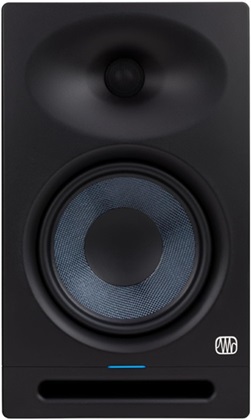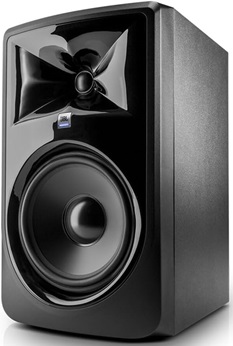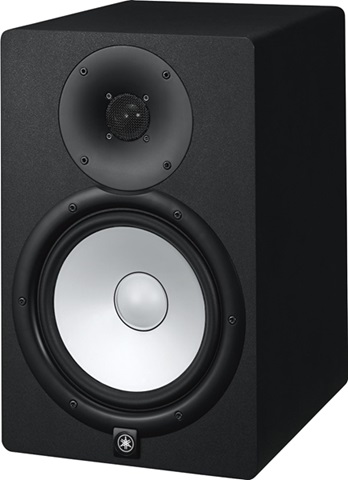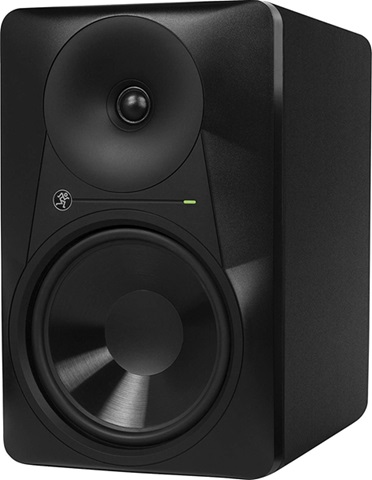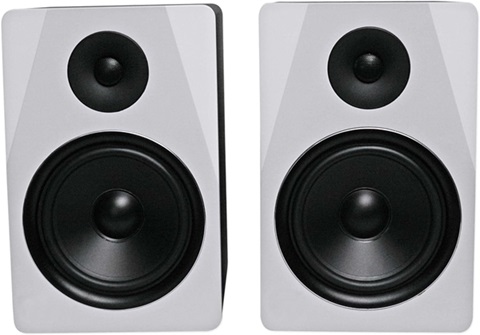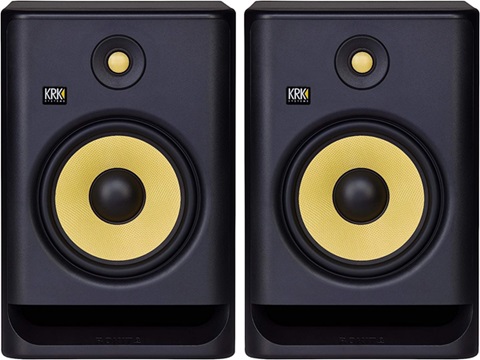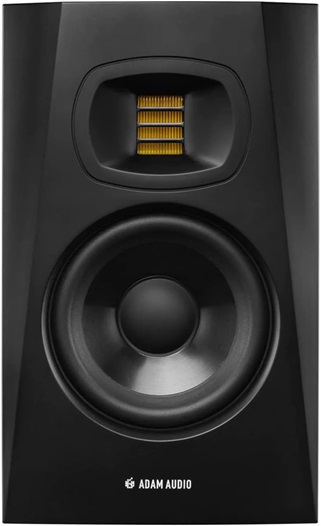Studio monitors are a crucial component of any music production setup, as they provide the accurate and neutral sound reproduction necessary for making informed decisions about mixes. 8-inch studio monitors offer a balance of size, performance, and affordability, making them a popular choice for many studios, both professional and home-based.
Key Features
- Power: The power output of a studio monitor determines how loud it can be driven before distortion occurs. For smaller rooms, a power output of 50-75 watts per speaker is typically sufficient. However, for larger rooms or for those who need more volume, a power output of 100 watts.
- Connectivity Technology: Studio monitors offer a variety of connectivity options to suit different studio setups. XLR inputs are the most professional connection type, providing a balanced and interference-resistant signal path. TRS inputs are also common, offering a balanced connection for devices that do not have XLR outputs. RCA inputs are less common but can be found on some budget studio monitors.
- Sensitivity: Sensitivity is a measure of how loud a speaker will play for a given input level. A higher sensitivity rating indicates that a speaker will play louder for the same input level. Studio monitors typically have a sensitivity rating of 85-95 decibels (dB) SPL.
Selecting the best 8″ studio monitors, considering their features such as frequency response, compatibility with devices, and power sources, can be challenging. To streamline this process, we offer a comprehensive “Buying Guide” to aid you in choosing the most suitable product effortlessly.
Outline
ToggleBest 8 Inch Studio Monitors Table
| Best 8 Inch Studio Monitors | Power | Connectivity Technology | Sensitivity | Buy Now |
|---|---|---|---|---|
| Presonus Studio Monitors | 150W | RCA, 1/4" TRS, XLR | 105db | Check On Amazon |
| JBL Professional Studio Monitors | 112 W | XLR | 108db | Check On Amazon |
| Yamaha Studio Monitors | 120W | TRS, XLR | - | Check On Amazon |
| Mackie Studio Monitors | 85W | - | 113db | Check On Amazon |
| Rockville Studio Monitors | 500W | RCA, USB, XLR | 100db | Check On Amazon |
| KRK Studio Monitors | 100W | - | - | Check On Amazon |
| Adam Audio Studio Monitors | 25 W | XLR | 118 db | Check On Amazon |
Best 8 Inch Studio Monitors Reviews
1. Presonus Studio Monitors
The PreSonus Eris Studio 8 is a professional monitor that delivers accurate and powerful sound, with a large sweet spot for an enhanced listening experience. Whether you’re in a home studio or a pro mix room, these monitors provide great features for an awesome audio experience. This Studio 8 excels in high frequencies using a 1.25-inch silk-dome tweeter and a custom-tuned 120˚ x 60˚ EBM waveguide. Paired with an 8-inch woven-composite low-frequency driver, it produces strong, precise bass. The front-facing port enhances the bass, with smart internal bracing to reduce unwanted resonance. Powered by a 140W Class AB bi-amplification system, the Eris Studio 8 can get really loud (105 dB SPL) without losing its balanced sound.
Easily connect these monitors to mixers and audio gear, tweak your sound with the controls, and rest assured with protective features like RF interference and subsonic protection. It’s a solid pick for those who want clear sound, strong bass, and flexible connections. It’s perfect for mixing and mastering.
Best Features
- Easy connection to various devices.
- Room sound adjustment.
- Loud and clear sound without sacrificing quality.
- Enhancing bass reproduction and overall durability.
Pros
- Accurate Sound Reproduction.
- Broad Frequency Response (35 Hz to 20 kHz).
- Powerful Bass Response.
Cons
- Class AB amplification may consume more power.
2. JBL Professional Studio Monitors
JBL 308P MkII studio monitor brings legendary JBL performance in a smooth, modern design. This monitor is all about accurate sound, thanks to the JBL Image Control Waveguide and refined transducers. The low-frequency port guarantees awesome bass in any setting.
The robust dual Class-D amps, boasting 112 watts, effectively manage demanding production tasks with exceptional output and dynamic range. The New Boundary feature ensures precise bass positioning, while the HF Trim allows you to adjust the high-frequency output to match your room or preference.
This monitor is easy to connect to any studio gear, to its balanced XLR and TRS inputs, input-sensitivity switch, and volume control. This monitor, meeting JBL’s standards, ensures accurate mixes anywhere, with consistent sound. Its sleek design adds style, and the wide sweet spot lets you fine-tune your mix from various angles in your creative space.
Best Features
- This product are designed to deliver accurate.
- Wide frequency response.
- High output and dynamic range
- High-quality components, and comprehensive protection circuitry.
Pros
- Studio monitors are made to accurately play sound.
- Detailed Monitoring.
- High quality sound.
Cons
- There’s a lot of static noise when the volume is turned up all the way.
3. Yamaha Studio Monitors
The Yamaha HS8 is a top-tier studio monitor, known for its unmatched sound precision. Musicians, producers, and engineers adore it for its accurate representation of audio mixes. Boasting an 8-inch cone woofer and a 1-inch dome tweeter, it delivers an expansive frequency response ranging from 38Hz to 30kHz. The bi-amplification system, with 120 watts, effortlessly reproduces intricate audio signals.
Adjusting to your studio, the product has controls for room and high trim response, customizing your sound. With balanced and unbalanced inputs like XLR and TRS, it works seamlessly with mixers, keyboards, and audio interfaces.
Designed for the purist pursuit of accurate sound reproduction, the HS8 is an optimal choice for mixing and mastering.
Best Features
- Providing an accurate representation of audio.
- Wide Frequency Range.
- Adjustment Controls.
- Ensuring compatibility with various audio sources.
Pros
- Ideal for critical listening.
- Professional Quality.
- Powerful bass response
Cons
- May not be suitable for small rooms
4. Mackie Studio Monitors
Mackie MR824 Powered Studio Monitors, crafted to bring top-notch mix translation and accuracy for professional studio results. These monitors feature a proven logarithmic waveguide design, ensuring ultra-wide dispersion and enhanced stereo imaging.
The MR824 monitors are built for accurate audio reproduction, equipped with a 1-inch silk dome tweeter for detailed high-end and fast transient response, paired with an 8-inch polypropylene woofer for responsive and dynamic low-frequency output. With 65 watts of bi-amplified Class A/B power for each monitor, these studio monitors provide precise mix translation, perfect for tasks like mixing and mastering.
The waveguide design ensures that the sound remains consistent from various angles, providing a broad listening area. The 8-inch woofer’s strong bass and customizable Acoustic Space Control adapt to various room environments and preferences
Best Features
- 65 watts of bi-amplified Class A/B amplification for each monitor.
- Proven design for ultra-wide dispersion and enhanced stereo imaging.
- 1-inch silk dome tweeter for fast transient response and detailed high-end.
- 8-inch polypropylene woofer for responsive, dynamic low-frequency response.
- Customizable feature for optimizing frequency response to your room environment.
Pros
- Ideal for mixing and mastering.
- Suitable for music production.
- Adjusting the room sound.
Cons
- It Consume more power.
5. Rockville Studio Monitors
Rockville APM8W is a strong contender in studio monitors, offering impressive features at a budget-friendly price. With an 8-inch woofer and a 1.5-inch silk dome tweeter, these powered monitors provide a total power of 500 watts. Each driver has its own amplifier for accurate and tailored performance across frequencies.
This product is made to be versatile with various input options like 1/4″ and XLR combo, RCA, and USB. At the back, there’s a power light, and the controls for volume, bass, and a headphone jack give you simple control over your sound. With a frequency range from 30Hz to 20kHz, the Rockville APM8W delivers precise bass and clear highs, making it great for music production, recording at home, DJing, live sound, and personal listening.
It stands out for its great sound quality, powerful output, and versatile connectivity, making it an ideal choice for musicians, producers, engineers, and DJs looking for affordable and dependable studio monitor speakers.
Best Features
- These monitors deliver a powerful sound that can fill any room.
- Provide flexibility for different audio sources.
- The frequency range from 30Hz to 20 kHz
- It accessible for musicians, producers, engineers, and DJs.
Pros
- Sound quality is good.
- it is user-friendly.
- easy visual confirmation.
Cons
- No auto on/off feature
6. KRK Studio Monitors
KRK RP8 G4 is a great option for professionals, providing clear and detailed sound for tasks such as mixing, mastering, video editing, and various audio production. These monitors boast an 8-inch matching woofer and a 1-inch tweeter made from robust Kevlar for optimal sound quality. The strong Class D amplifier and special speaker design make sure the performance is reliable, reducing distortion.
These monitors come with a built-in screen and EQ, making it easy to adjust the room sound for better clarity and less acoustic issues. The design also makes sure the bass is accurate and vibrations are minimal, creating a precise sound. Advanced Aramid Fiber drivers improve airflow, reducing turbulence and enhancing low-frequency response
Best Features
- DSP-driven Active Room Tuning with 25 Graphic EQ settings.
- KRK App for accurate EQ calibration (iOS and Android).
- 8-inch matching woofer and 1-inch tweeter made with Kevlar.
- Low-resonance enclosure and front-firing port for accurate bass.
- High-density Iso-foam pad minimizes vibration transmission.
- Efficient Class D power amplifier for powerful performance.
Pros
- Precise and clear sound.
- Powerful and reliable performance.
- Sound quality and hardware quality is good.
Cons
- Not ideal for use in very small rooms.
7. Adam Audio Studio Monitors
Adam Audio T8V redefines the landscape of studio monitors, seamlessly merging professional-grade sound excellence with an accessible price point. This 8-inch studio monitor is a testament to achieving perfect audio without sacrificing affordability. The T8V’s advanced U-ART tweeter makes your music sound clear and lively, with exceptional clarity in the highs. The T8V’s U-ART tweeter is your key to excellent sound whether you’re perfecting a symphony or diving into the details of a finely mixed track.
The HPS waveguide improves the standout tweeter, spreading sound beyond the usual limits. The T8V uses the HPS waveguide to spread sound evenly, creating a spacious and immersive listening experience. Say goodbye to limited listening areas – the studio monitor ensures rich and balanced audio throughout your space. The T8V is not just about hearing music; it’s about experiencing it in its complete, three-dimensional glory. Ideal for those seeking high-quality sound on a budget, this product balances quality and affordability, setting a new standard for studio-grade audio excellence.
Best Features
- flat frequency response.
- wide sweet spot.
- low noise floor.
- durable build quality.
- A variety of input and output options.
Pros
- Accurate sound reproduction.
- Providing a richer and fuller low-end experience.
- Increased headroom and SPL.
- Versatility for various genres.
Cons
- Larger physical size.
Buying Guide for Best 8 Inch Studio Monitors
1. Power
The power output of studio monitors is measured in watts (W). The higher the power output, the louder the monitors can play. For an 8-inch studio monitor, a power output of 50W per monitor is a good starting point. However, if you need to produce loud mixes or work in a large room, you may want to choose monitors with a higher power output.
2. Connectivity Technology
Most 8-inch studio monitors will have balanced TRS and unbalanced RCA inputs. This allows you to connect them to a variety of audio sources, such as mixers, audio interfaces, and computers. Some monitors may also have additional inputs, such as Bluetooth or optical inputs.
3. Sensitivity
The sensitivity of a studio monitor is measured in decibels per milliwatt (dB/mW). It is a measure of how loud the monitor will play at a given power level. A higher sensitivity rating means that the monitor will play louder at the same power level. For an 8-inch studio monitor, a sensitivity rating of 85 dB/mW or higher is good.
4. Subwoofer & Tweeter Size
The size of the subwoofer and tweeter will affect the frequency response of the studio monitor. A larger subwoofer will reproduce lower frequencies better, while a larger tweeter will reproduce higher frequencies better. For most genres of music, a subwoofer diameter of 5-8 inches and a tweeter diameter of 1-1.5 inches is sufficient.
5. Frequency Response
Frequency response is the range of frequencies that a speaker can reproduce. A wider frequency response will allow you to hear more of the details in your mixes. Studio monitors typically have a frequency response of 50-20,000 Hz, which covers the entire range of human hearing.
6. Sound Quality
The sound quality of a studio monitor is subjective and depends on personal preference. Some studio monitors are known for their neutral sound reproduction, while others are known for their punchy bass or clear mids. It is important to listen to different studio monitors and choose one that sounds good to you.
7. Amplification
Studio monitors can be powered or passive. Powered studio monitors have built-in amplifiers, while passive studio monitors require an external amplifier. Powered studio monitors are more convenient, but passive studio monitors can be more affordable.
8. Design
Studio monitors come in a variety of designs, including bookshelf, stand-mounted, and nearfield monitors. Bookshelf monitors are designed to be placed on shelves or desks, while stand-mounted monitors are designed to be placed on stands. Nearfield monitors are designed to be placed close to the listener, typically within a few feet.
8 Inch Studio Monitors – FAQs
A studio monitor will provide minimal distortion, a wide frequency response, neutral sound coloration, and a high volume level even with a small cabinet. studio monitors give a clear stereo image, helping engineers place sounds accurately.
2.Do studio monitors need a Subwoofers?
Yes, if your projects require deep low-end monitoring. Adding a studio subwoofer can significantly enhance your audio experience, especially if your monitors already handle low frequencies effectively.
Picking studio monitors depends on room size, music style, and budget. First, nail the room’s acoustic treatment for optimal monitor performance.
Unlike home stereo speakers that boost certain tones, studio monitors keep it flat—no enhancements. This gives you cleaner, truer sound for precise mixing.
Conclusion
The best 8-inch studio monitors for you will depend on your individual needs and budget, size of the room, performance and type of music you play. However, all are the studio monitors in this list is the best option for everyone.
- Overall, the best 8-inch studio monitors for most people are the PreSonus Studio Monitors. They offer a great balance of sound quality, features, and price. They are also very versatile and can be used for a variety of applications, including mixing, mastering, and playback.
- If you are looking for the best possible sound quality, then the Yamaha Studio Monitors are the way to go. These monitors are both very accurate and can reproduce even the most subtle details in your music.
- The Adam Audio Studio Monitors is another great option for those who are looking for a high-end monitor. It offers a unique combination of clarity and power, making it a great choice for both professional and home studio use.

